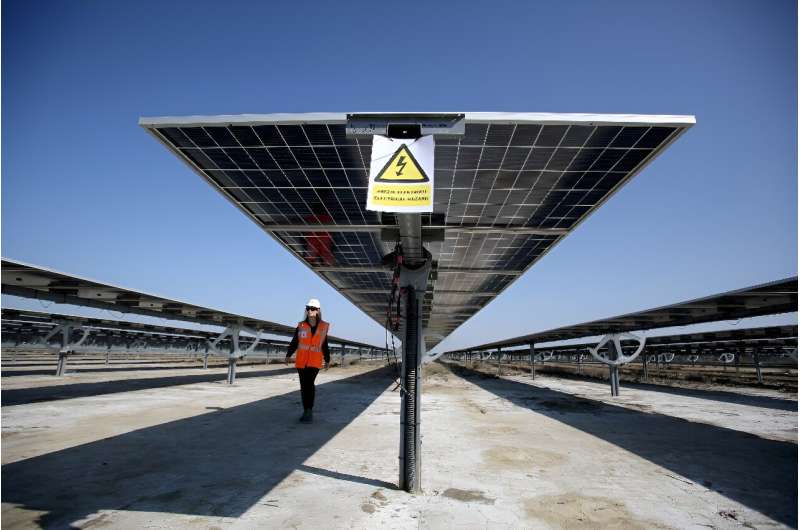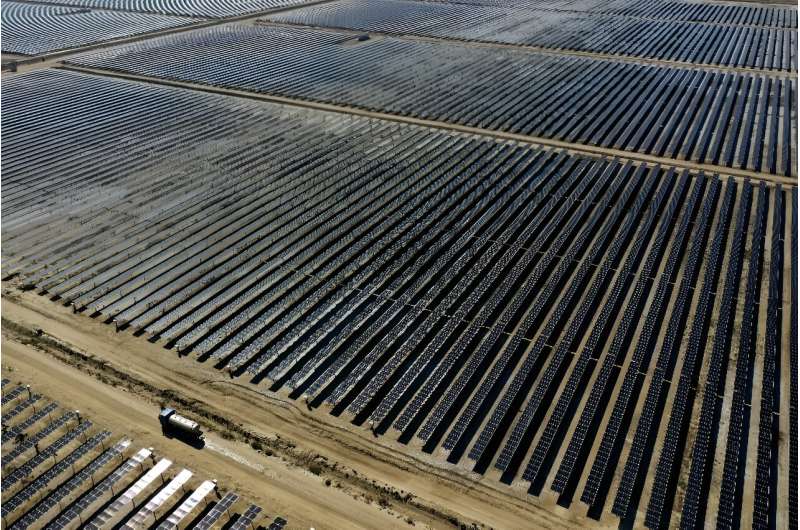This article has been reviewed according to Science X's editorial process and policies. Editors have highlighted the following attributes while ensuring the content's credibility:
fact-checked
reputable news agency
proofread
Sunny Albania turns to solar power to fuel development

Along southwestern Albania's coastline, the sun shines bright—warming the 234,828 new solar panels at the Karavasta power station that will be connected to the country's energy grid in the coming weeks.
In less than two years, the French-owned Voltalia company has built the largest solar-powered plant in the Western Balkans, where much of the region remains reliant on fossil fuels including coal.
Located on 200 hectares of land provided by the Albanian government on the edge of the Karavasta lagoon national park, the plant will be able to generate 140 megawatts, powering hundreds of thousands of homes in the country of just 2.8 million people.
The surge in energy will be a welcome shot in the arm for the Balkan country—where power outages were long a scourge following the collapse of its communist governments in the early 1990s.
And while the grid has stabilized in recent years, power cuts are still common.
Albania currently receives approximately 99 percent of its electricity from hydroelectric power stations.
But with regular droughts and ramshackle energy infrastructure dating back to its communist era, Albanian has struggled to keep pace with the country's break-neck development fueled by the millions of tourists it welcomes annually.
A groundswell of activism in recent years against a string of new hydropower projects pushed the Albanian government to create a national park last year to protect the Vjosa River, one of Europe's largest undammed waterways.
With the construction of dams on hold, Karavasta's backers hope that 300 average days of sunshine a year will ensure the stable production of power.
"From this winter, 100 percent of the energy produced by the Karavasta solar power plant will be sold to the Albanian national company," Constantin von Alvensleben, Voltalia's country manager for Albania, tells AFP.
"If Albania generates surplus electricity, it will be able to export it to users in neighboring countries such as Greece, Italy, Kosovo, Montenegro and Northern Macedonia."
Although the country promotes its green energy sector, Albania produces around 650,000 metric tons of crude oil annually from dilapidated infrastructure that environmentalists have long criticized for the harm it wreaks on local communities.

Frogs and pelicans
But along its sun-drenched coastline, engineers say the terrain is ideal for solar parks.
Luca Anthouard, an engineer working on the project, says the salty, unfarmable tracts of land around Karavasta have enabled developers to build a project "on a grand scale by European standards".
But before the panels were erected, the cracked earth was home to small green frogs—known as Pelophylax Shqipericus, or Albanian frogs.
"[They are] a protected species," said Vilma Terpollari, Voltalia's environmental adviser who is also responsible for ensuring that the amphibians return to the site in large numbers.
"We have drawn up specific projects to protect this species by creating new habitats so that it can return and reproduce here," she added.
Throughout the sprawling development, photos of this small frog with a fluorescent green line across its back remind workers to take care.
The project also features thick power lines carrying electricity from the solar park to a redistribution station that could disturb the flightpath of birds.
"Voltalia has installed bird diverters," said Terpollari, "a first in Albania".
The feature—which is essentially a large tower that makes the power lines more visible—is all the more important due to southwestern Albania's location across migratory flyways and nesting areas that are home to pelicans and pink flamingos.
Millions of birds pass through the nearby Narta lagoon and Karavasta estuary every year, providing critical grounds for migratory species traveling between northern Europe and the African continent.
As for the inhabitants of the surrounding villages, 53 families had their land appropriated to make way for the construction of the power station and the power line.
"They will be reimbursed by the state, in accordance with the law," said Ramatlen Bollobani, an advisor to the project, adding that Voltalia would also contribute to compensation for the families.
Only one family is contesting the land dispute.
© 2023 AFP


















